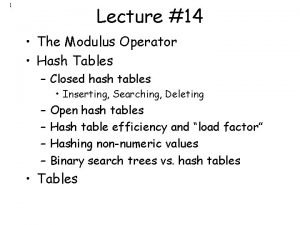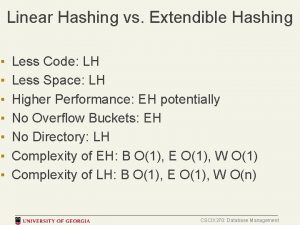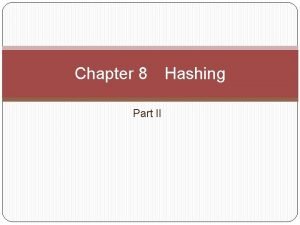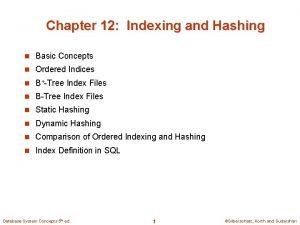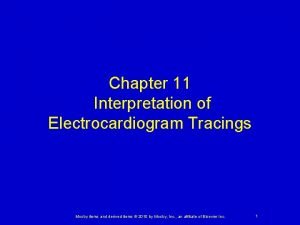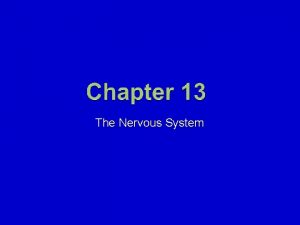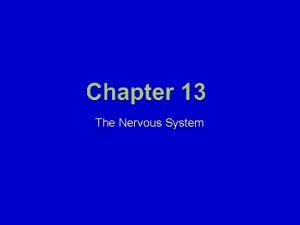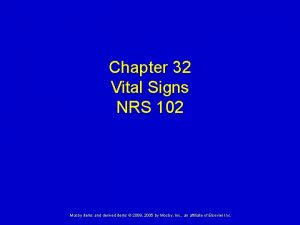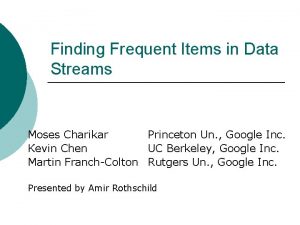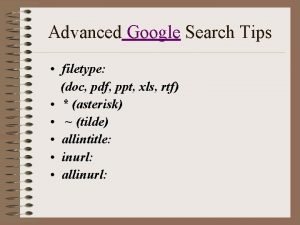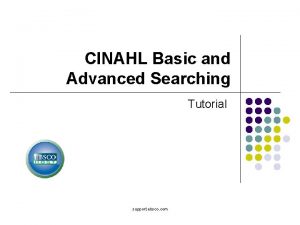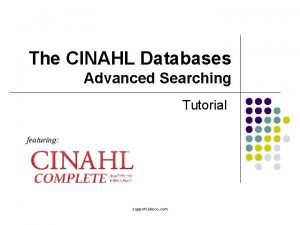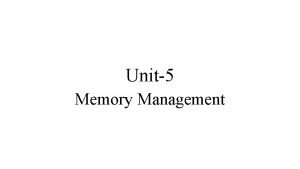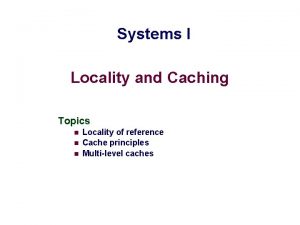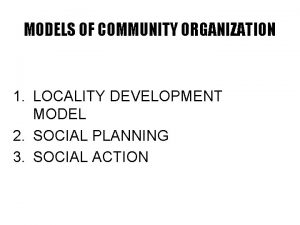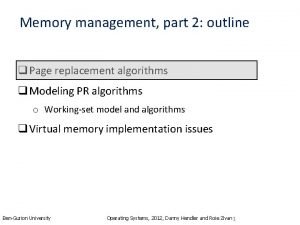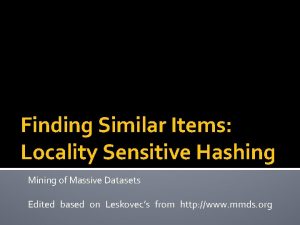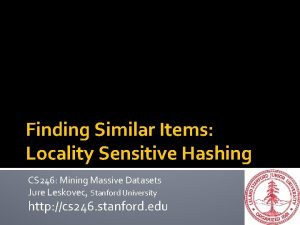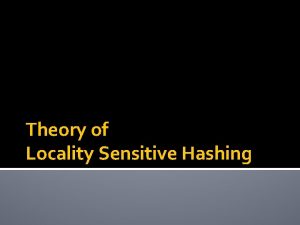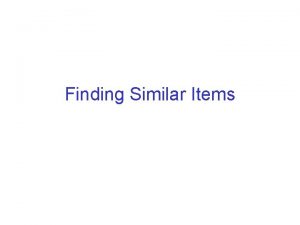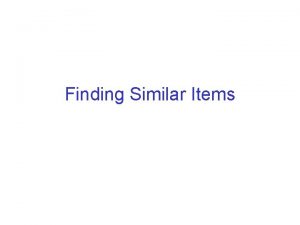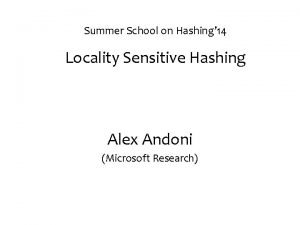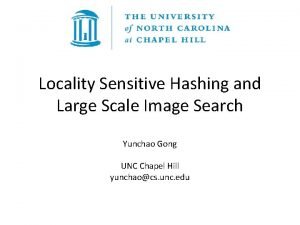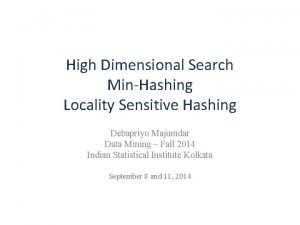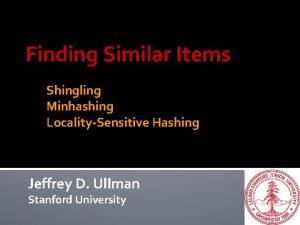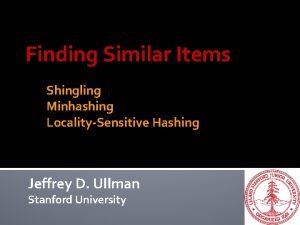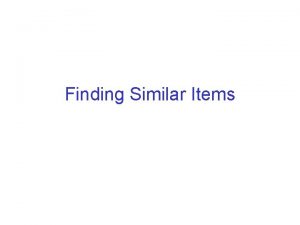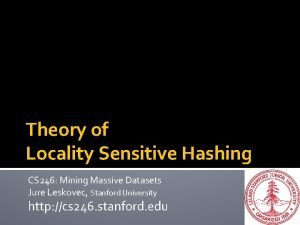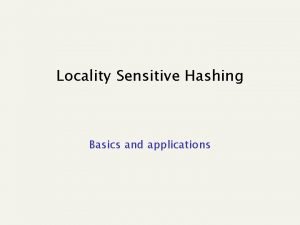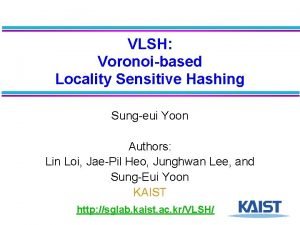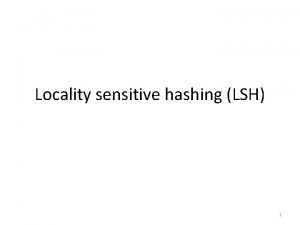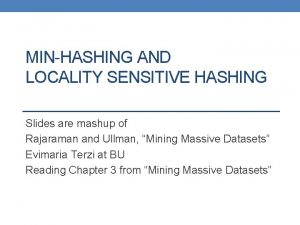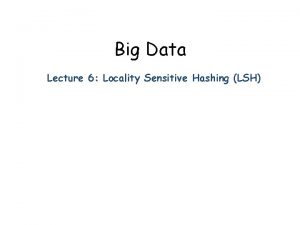Finding Similar Items Locality Sensitive Hashing Advanced Search


























![Similarity for Signatures �We know: Pr[h (C 1) = h (C 2)] = sim(C Similarity for Signatures �We know: Pr[h (C 1) = h (C 2)] = sim(C](https://slidetodoc.com/presentation_image_h/232c68cbb7cf282cb087256d9bad570d/image-27.jpg)























- Slides: 50

Finding Similar Items: Locality Sensitive Hashing Advanced Search Techniques for Large Scale Data Analytics Pavel Zezula and Jan Sedmidubsky Masaryk University http: //disa. fi. muni. cz

Similarity Search �Similarity search examples: § Images, faces, motions, time series… § + visual examples Pavel Zezula, Jan Sedmidubsky. Advanced Search Techniques for Large Scale Data Analytics (PA 212) 2

A Common Metaphor �Many problems can be expressed as finding “similar” sets: § Find near-neighbors in high-dimensional space �Examples: § Pages with similar words § For duplicate detection, classification by topic § Customers who purchased similar products § Products with similar customer sets § Images with similar features § Users who visited similar websites Pavel Zezula, Jan Sedmidubsky. Advanced Search Techniques for Large Scale Data Analytics (PA 212) 3

Problem for Today’s Lecture � Pavel Zezula, Jan Sedmidubsky. Advanced Search Techniques for Large Scale Data Analytics (PA 212) 4

Finding Similar Items

Distance Measures �Goal: Find near-neighbors in high-dim. space § We formally define “near neighbors” as points that are a “small distance” apart �For each application, we first need to define what “distance” means �Today: Jaccard distance/similarity § The Jaccard similarity of two sets is the size of their intersection divided by the size of their union: sim(C 1, C 2) = |C 1 C 2|/|C 1 C 2| § Jaccard distance: d(C 1, C 2) = 1 - |C 1 C 2|/|C 1 C 2| 3 in intersection 8 in union Jaccard similarity= 3/8 Jaccard distance = 5/8 Pavel Zezula, Jan Sedmidubsky. Advanced Search Techniques for Large Scale Data Analytics (PA 212) 6

Task: Finding Similar Documents � Pavel Zezula, Jan Sedmidubsky. Advanced Search Techniques for Large Scale Data Analytics (PA 212) 7

3 Essential Steps for Similar Docs 1. Shingling: Convert documents to sets 2. Min-Hashing: Convert large sets to short signatures, while preserving similarity 3. Locality-Sensitive Hashing: Focus on pairs of signatures likely to be from similar documents § Candidate pairs! Pavel Zezula, Jan Sedmidubsky. Advanced Search Techniques for Large Scale Data Analytics (PA 212) 8

The Big Picture Document Locality. Sensitive Hashing Min Hashing Shingling The set of strings of length k that appear in the document Signatures: short integer vectors that represent the sets, and reflect their similarity Pavel Zezula, Jan Sedmidubsky. Advanced Search Techniques for Large Scale Data Analytics (PA 212) Candidate pairs: those pairs of signatures that we need to test for similarity 9

Document Shingling The set of strings of length k that appear in the document Shingling Step 1: Shingling: Convert documents to sets

Documents as High-Dim Data �Step 1: Shingling: Convert documents to sets �Simple approaches: § Document = set of words appearing in document § Document = set of “important” words § Don’t work well for this application. Why? �Need to account for ordering of words! �A different way: Shingles! Pavel Zezula, Jan Sedmidubsky. Advanced Search Techniques for Large Scale Data Analytics (PA 212) 11

Define: Shingles �A k-shingle (or k-gram) for a document is a sequence of k tokens that appears in the doc § Tokens can be characters, words or something else, depending on the application § Assume tokens = characters for examples �Example: k=2; document D 1 = abcab Set of 2 -shingles: S(D 1) = {ab, bc, ca} § Option: Shingles as a bag (multiset), count ab twice: S’(D 1) = {ab, bc, ca, ab} Pavel Zezula, Jan Sedmidubsky. Advanced Search Techniques for Large Scale Data Analytics (PA 212) 12

Compressing Shingles �To compress long shingles, we can hash them to (say) 4 bytes �Represent a document by the set of hash values of its k-shingles § Idea: Two documents could (rarely) appear to have shingles in common, when in fact only the hash-values were shared �Example: k=2; document D 1= abcab Set of 2 -shingles: S(D 1) = {ab, bc, ca} Hash the singles: h(D 1) = {1, 5, 7} Pavel Zezula, Jan Sedmidubsky. Advanced Search Techniques for Large Scale Data Analytics (PA 212) 13

Similarity Metric for Shingles �Document D 1 is a set of its k-shingles C 1=S(D 1) �Equivalently, each document is a 0/1 vector in the space of k-shingles § Each unique shingle is a dimension § Vectors are very sparse �A natural similarity measure is the Jaccard similarity: sim(D 1, D 2) = |C 1 C 2|/|C 1 C 2| Pavel Zezula, Jan Sedmidubsky. Advanced Search Techniques for Large Scale Data Analytics (PA 212) 14

Working Assumption �Documents that have lots of shingles in common have similar text, even if the text appears in different order �Caveat: You must pick k large enough, or most documents will have most shingles § k = 5 is OK for short documents § k = 10 is better for long documents Pavel Zezula, Jan Sedmidubsky. Advanced Search Techniques for Large Scale Data Analytics (PA 212) 15

Motivation for Minhash/LSH � Pavel Zezula, Jan Sedmidubsky. Advanced Search Techniques for Large Scale Data Analytics (PA 212) 16

Document Min-Hashing Shingling The set of strings of length k that appear in the document Signatures: short integer vectors that represent the sets, and reflect their similarity Min. Hashing Step 2: Minhashing: Convert large sets to short signatures, while preserving similarity

Encoding Sets as Bit Vectors � Many similarity problems can be formalized as finding subsets that have significant intersection � Encode sets using 0/1 (bit, boolean) vectors § One dimension per element in the universal set � Interpret set intersection as bitwise AND, and set union as bitwise OR � Example: C 1 = 10111; C 2 = 10011 § Size of intersection = 3; size of union = 4, § Jaccard similarity (not distance) = 3/4 § Distance: d(C 1, C 2) = 1 – (Jaccard similarity) = 1/4 Pavel Zezula, Jan Sedmidubsky. Advanced Search Techniques for Large Scale Data Analytics (PA 212) 18

From Sets to Boolean Matrices �Rows = elements (shingles) �Columns = sets (documents) �Each document is a column: § Example: sim(C 1 , C 2) = ? § Size of intersection = 3; size of union = 6, Jaccard similarity (not distance) = 3/6 § d(C 1, C 2) = 1 – (Jaccard similarity) = 3/6 Shingles § 1 in row e and column s if and only if e is a member of s § Column similarity is the Jaccard similarity of the corresponding sets (rows with value 1) § Typical matrix is sparse! Documents 1 1 1 0 0 0 1 1 0 1 0 Pavel Zezula, Jan Sedmidubsky. Advanced Search Techniques for Large Scale Data Analytics (PA 212) 19

Outline: Finding Similar Columns �So far: § Documents Sets of shingles § Represent sets as boolean vectors in a matrix �Next goal: Find similar columns while computing small signatures § Similarity of columns == similarity of signatures Pavel Zezula, Jan Sedmidubsky. Advanced Search Techniques for Large Scale Data Analytics (PA 212) 20

Outline: Finding Similar Columns �Next Goal: Find similar columns, Small signatures �Naïve approach: § 1) Signatures of columns: small summaries of columns § 2) Examine pairs of signatures to find similar columns § Essential: Similarities of signatures and columns are related § 3) Optional: Check that columns with similar signatures are really similar �Warnings: § Comparing all pairs may take too much time: Job for LSH § These methods can produce false negatives, and even false positives (if the optional check is not made) Pavel Zezula, Jan Sedmidubsky. Advanced Search Techniques for Large Scale Data Analytics (PA 212) 21

Hashing Columns (Signatures) �Key idea: “hash” each column C to a small signature h(C), such that: § (1) h(C) is small enough that the signature fits in RAM § (2) sim(C 1, C 2) is the same as the “similarity” of signatures h(C 1) and h(C 2) �Goal: Find a hash function h(·) such that: § If sim(C 1, C 2) is high, then with high prob. h(C 1) = h(C 2) § If sim(C 1, C 2) is low, then with high prob. h(C 1) ≠ h(C 2) �Hash docs into buckets. Expect that “most” pairs of near duplicate docs hash into the same bucket! Pavel Zezula, Jan Sedmidubsky. Advanced Search Techniques for Large Scale Data Analytics (PA 212) 22

Min-Hashing �Goal: Find a hash function h(·) such that: § if sim(C 1, C 2) is high, then with high prob. h(C 1) = h(C 2) § if sim(C 1, C 2) is low, then with high prob. h(C 1) ≠ h(C 2) �Clearly, the hash function depends on the similarity metric: § Not all similarity metrics have a suitable hash function �There is a suitable hash function for the Jaccard similarity: It is called Min-Hashing Pavel Zezula, Jan Sedmidubsky. Advanced Search Techniques for Large Scale Data Analytics (PA 212) 23

Min-Hashing �Imagine the rows of the boolean matrix permuted under random permutation �Define a “hash” function h (C) = the index of the first (in the permuted order ) row in which column C has value 1: h (C) = min (C) �Use several (e. g. , 100) independent hash functions (that is, permutations) to create a signature of a column Pavel Zezula, Jan Sedmidubsky. Advanced Search Techniques for Large Scale Data Analytics (PA 212) 24

Min-Hashing Example Note: Another (equivalent) way is to 1 5 1 store row indexes: 2 6 3 4 1 6 2 nd element of the permutation is the first to map to a 1 Permutation Input matrix (Shingles x Documents) Signature matrix M 2 4 3 1 0 2 1 3 2 4 1 0 0 1 7 0 1 2 1 4 1 6 3 2 0 1 1 2 1 6 6 0 1 5 7 1 1 0 4 5 5 1 0 4 th element of the permutation is the first to map to a 1 Pavel Zezula, Jan Sedmidubsky. Advanced Search Techniques for Large Scale Data Analytics (PA 212) 25 5 3 4

The Min-Hash Property 0 0 �Choose a random permutation �Claim: Pr[h (C 1) = h (C 2)] = sim(C 1, C 2) �Why? 1 1 0 0 0 1 1 0 § Let X be a doc (set of shingles), y X is a shingle § Then: Pr[ (y) = min( (X))] = 1/|X| § It is equally likely that any y X is mapped to the min element § Let y be s. t. (y) = min( (C 1 C 2)) One of the two § Then either: (y) = min( (C 1)) if y C 1 , or cols had to have (y) = min( (C 2)) if y C 2 1 at position y § So the prob. that both are true is the prob. y C 1 C 2 § Pr[min( (C 1))=min( (C 2))]=|C 1 C 2|/|C 1 C 2|= sim(C 1, C 2) Pavel Zezula, Jan Sedmidubsky. Advanced Search Techniques for Large Scale Data Analytics (PA 212) 26
![Similarity for Signatures We know Prh C 1 h C 2 simC Similarity for Signatures �We know: Pr[h (C 1) = h (C 2)] = sim(C](https://slidetodoc.com/presentation_image_h/232c68cbb7cf282cb087256d9bad570d/image-27.jpg)
Similarity for Signatures �We know: Pr[h (C 1) = h (C 2)] = sim(C 1, C 2) �Now generalize to multiple hash functions �The similarity of two signatures is the fraction of the hash functions in which they agree �Note: Because of the Min-Hash property, the similarity of columns is the same as the expected similarity of their signatures Pavel Zezula, Jan Sedmidubsky. Advanced Search Techniques for Large Scale Data Analytics (PA 212) 28

Min-Hashing Example Permutation Input matrix (Shingles x Documents) Signature matrix M 2 4 3 1 0 2 1 3 2 4 1 0 0 1 7 0 1 2 1 4 1 6 3 2 0 1 1 2 1 6 6 0 1 5 7 1 1 0 4 5 5 1 0 Similarities: 1 -3 2 -4 1 -2 3 -4 Col/Col 0. 75 0 0 Sig/Sig 0. 67 1. 00 0 0 Pavel Zezula, Jan Sedmidubsky. Advanced Search Techniques for Large Scale Data Analytics (PA 212) 29

Min-Hash Signatures � Pavel Zezula, Jan Sedmidubsky. Advanced Search Techniques for Large Scale Data Analytics (PA 212) 30

Implementation Trick �Permuting rows even once is prohibitive �Row hashing! § Pick K = 100 hash functions ki § Ordering under ki gives a random row permutation! �One-pass implementation § For each column C and hash-func. ki keep a “slot” for the min-hash value § Initialize all sig(C)[i] = How to pick a random hash function h(x)? § Scan rows looking for 1 s § Suppose row j has 1 in column C § Then for each ki : § If ki(j) < sig(C)[i], then sig(C)[i] ki(j) Universal hashing: ha, b(x)=((a·x+b) mod p) mod N where: a, b … random integers p … prime number (p > N) Pavel Zezula, Jan Sedmidubsky. Advanced Search Techniques for Large Scale Data Analytics (PA 212) 31

Document Min-Hashing Shingling The set of strings of length k that appear in the document Locality. Sensitive Hashing Signatures: short integer vectors that represent the sets, and reflect their similarity Candidate pairs: those pairs of signatures that we need to test for similarity Locality Sensitive Hashing Step 3: Locality-Sensitive Hashing: Focus on pairs of signatures likely to be from similar documents

LSH: First Cut 2 1 4 1 1 2 2 1 �Goal: Find documents with Jaccard similarity at least s (for some similarity threshold, e. g. , s=0. 8) �LSH – General idea: Use a function f(x, y) that tells whether x and y is a candidate pair: a pair of elements whose similarity must be evaluated �For Min-Hash matrices: § Hash columns of signature matrix M to many buckets § Each pair of documents that hashes into the same bucket is a candidate pair Pavel Zezula, Jan Sedmidubsky. Advanced Search Techniques for Large Scale Data Analytics (PA 212) 33

Candidates from Min-Hash 2 1 4 1 1 2 2 1 �Pick a similarity threshold s (0 < s < 1) �Columns x and y of M are a candidate pair if their signatures agree on at least fraction s of their rows: M (i, x) = M (i, y) for at least frac. s values of i § We expect documents x and y to have the same (Jaccard) similarity as their signatures Pavel Zezula, Jan Sedmidubsky. Advanced Search Techniques for Large Scale Data Analytics (PA 212) 34

LSH for Min-Hash 2 1 4 1 1 2 2 1 �Big idea: Hash columns of signature matrix M several times �Arrange that (only) similar columns are likely to hash to the same bucket, with high probability �Candidate pairs are those that hash to the same bucket Pavel Zezula, Jan Sedmidubsky. Advanced Search Techniques for Large Scale Data Analytics (PA 212) 35

Partition M into b Bands 2 1 4 1 1 2 2 1 r rows per band b bands One signature Signature matrix M Pavel Zezula, Jan Sedmidubsky. Advanced Search Techniques for Large Scale Data Analytics (PA 212) 36

Partition M into Bands �Divide matrix M into b bands of r rows �For each band, hash its portion of each column to a hash table with k buckets § Make k as large as possible �Candidate column pairs are those that hash to the same bucket for ≥ 1 band �Tune b and r to catch most similar pairs, but few non-similar pairs Pavel Zezula, Jan Sedmidubsky. Advanced Search Techniques for Large Scale Data Analytics (PA 212) 37

Hashing Bands Buckets Columns 2 and 6 are probably identical (candidate pair) Columns 6 and 7 are surely different. Matrix M r rows b bands Pavel Zezula, Jan Sedmidubsky. Advanced Search Techniques for Large Scale Data Analytics (PA 212) 38

Simplifying Assumption �There are enough buckets that columns are unlikely to hash to the same bucket unless they are identical in a particular band �Hereafter, we assume that “same bucket” means “identical in that band” �Assumption needed only to simplify analysis, not for correctness of algorithm Pavel Zezula, Jan Sedmidubsky. Advanced Search Techniques for Large Scale Data Analytics (PA 212) 39

Example of Bands 2 1 4 1 1 2 2 1 Assume the following case: �Suppose 100, 000 columns of M (100 k docs) �Signatures of 100 integers (rows) �Therefore, signatures take 40 Mb �Choose b = 20 bands of r = 5 integers/band �Goal: Find pairs of documents that are at least s = 0. 8 similar Pavel Zezula, Jan Sedmidubsky. Advanced Search Techniques for Large Scale Data Analytics (PA 212) 40

C 1, C 2 are 80% Similar 2 1 4 1 1 2 2 1 �Find pairs of s=0. 8 similarity, set b=20, r=5 �Assume: sim(C 1, C 2) = 0. 8 § Since sim(C 1, C 2) s, we want C 1, C 2 to be a candidate pair: We want them to hash to at least 1 common bucket (at least one band is identical) �Probability C 1, C 2 identical in one particular band: (0. 8)5 = 0. 328 �Probability C 1, C 2 are not similar in all of the 20 bands: (1 -0. 328)20 = 0. 00035 § i. e. , about 1/3000 th of the 80%-similar column pairs are false negatives (we miss them) § We would find 99. 965% pairs of truly similar documents Pavel Zezula, Jan Sedmidubsky. Advanced Search Techniques for Large Scale Data Analytics (PA 212) 41

C 1, C 2 are 30% Similar 2 1 4 1 1 2 2 1 �Find pairs of s=0. 8 similarity, set b=20, r=5 �Assume: sim(C 1, C 2) = 0. 3 § Since sim(C 1, C 2) < s we want C 1, C 2 to hash to NO common buckets (all bands should be different) �Probability C 1, C 2 identical in one particular band: (0. 3)5 = 0. 00243 �Probability C 1, C 2 identical in at least 1 of 20 bands: 1 - (1 - 0. 00243)20 = 0. 0474 § In other words, approximately 4. 74% pairs of docs with similarity 0. 3% end up becoming candidate pairs § They are false positives since we will have to examine them (they are candidate pairs) but then it will turn out their similarity is below threshold s Pavel Zezula, Jan Sedmidubsky. Advanced Search Techniques for Large Scale Data Analytics (PA 212) 42

LSH Involves a Tradeoff 2 1 4 1 1 2 2 1 �Pick: § The number of Min-Hashes (rows of M) § The number of bands b, and § The number of rows r per band to balance false positives/negatives �Example: If we had only 15 bands of 5 rows, the number of false positives would go down, but the number of false negatives would go up Pavel Zezula, Jan Sedmidubsky. Advanced Search Techniques for Large Scale Data Analytics (PA 212) 43

Probability of sharing a bucket No chance if t < s Similarity threshold s Analysis of LSH – What We Want Probability = 1 if t > s Similarity t =sim(C 1, C 2) of two sets Pavel Zezula, Jan Sedmidubsky. Advanced Search Techniques for Large Scale Data Analytics (PA 212) 44

What 1 Band of 1 Row Gives You Probability of sharing a bucket Remember: Probability of equal hash-values = similarity Similarity t =sim(C 1, C 2) of two sets Pavel Zezula, Jan Sedmidubsky. Advanced Search Techniques for Large Scale Data Analytics (PA 212) 45

b bands, r rows/band �Columns C 1 and C 2 have similarity t �Pick any band (r rows) § Prob. that all rows in band equal = tr § Prob. that some row in band unequal = 1 - tr �Prob. that no band identical = (1 - tr)b �Prob. that at least 1 band identical = 1 - (1 - tr)b Pavel Zezula, Jan Sedmidubsky. Advanced Search Techniques for Large Scale Data Analytics (PA 212) 46

What b Bands of r Rows Gives You At least one band identical Probability of sharing a bucket s ~ (1/b)1/r Similarity t=sim(C 1, C 2) of two sets No bands identical 1 - (1 -t r )b Some row of a band unequal Pavel Zezula, Jan Sedmidubsky. Advanced Search Techniques for Large Scale Data Analytics (PA 212) All rows of a band are equal 47

Example: b = 20; r = 5 �Similarity threshold s �Prob. that at least 1 band is identical: s. 2. 3. 4. 5. 6. 7. 8 1 -(1 -sr)b. 006. 047. 186. 470. 802. 975. 9996 Pavel Zezula, Jan Sedmidubsky. Advanced Search Techniques for Large Scale Data Analytics (PA 212) 48

Picking r and b: The S-curve �Picking r and b to get the best S-curve Prob. sharing a bucket § 50 hash-functions (r=5, b=10) Blue area: False Negative rate Green area: False Positive rate Similarity Pavel Zezula, Jan Sedmidubsky. Advanced Search Techniques for Large Scale Data Analytics (PA 212) 49

LSH Summary �Tune M, b, r to get almost all pairs with similar signatures, but eliminate most pairs that do not have similar signatures �Check in main memory that candidate pairs really do have similar signatures �Optional: In another pass through data, check that the remaining candidate pairs really represent similar documents Pavel Zezula, Jan Sedmidubsky. Advanced Search Techniques for Large Scale Data Analytics (PA 212) 50

Summary: 3 Steps �Shingling: Convert documents to sets § We used hashing to assign each shingle an ID �Min-Hashing: Convert large sets to short signatures, while preserving similarity § We used similarity preserving hashing to generate signatures with property Pr[h (C 1) = h (C 2)] = sim(C 1, C 2) § We used hashing to get around generating random permutations �Locality-Sensitive Hashing: Focus on pairs of signatures likely to be from similar documents § We used hashing to find candidate pairs of similarity s Pavel Zezula, Jan Sedmidubsky. Advanced Search Techniques for Large Scale Data Analytics (PA 212) 51
 Linear probing hash table
Linear probing hash table Extendible hashing vs linear hashing
Extendible hashing vs linear hashing Motivation for dynamic hashing
Motivation for dynamic hashing Static hashing and dynamic hashing
Static hashing and dynamic hashing Mosby items and derived items
Mosby items and derived items Mosby items and derived items
Mosby items and derived items Mosby items and derived items
Mosby items and derived items Lliver
Lliver Mosby
Mosby Reproductive system
Reproductive system Mosby items and derived items
Mosby items and derived items Mosby items and derived items
Mosby items and derived items Autonomic drugs
Autonomic drugs Mosby items and derived items
Mosby items and derived items Absorptive atelectasis
Absorptive atelectasis Absorption atelectasis
Absorption atelectasis Mosby items and derived items
Mosby items and derived items Mosby items and derived items
Mosby items and derived items Mosby items and derived items
Mosby items and derived items Mosby items and derived items
Mosby items and derived items Mosby items and derived items
Mosby items and derived items Mosby items and derived items
Mosby items and derived items Mosby items and derived items
Mosby items and derived items Mosby items and derived items
Mosby items and derived items Mosby items and derived items
Mosby items and derived items Mosby items and derived items
Mosby items and derived items Mosby items and derived items
Mosby items and derived items Mosby items and derived items
Mosby items and derived items Mosby items and derived items
Mosby items and derived items Mosby items and derived items
Mosby items and derived items Mosby items and derived items
Mosby items and derived items Finding frequent items in data streams
Finding frequent items in data streams Similar disuelve a similar
Similar disuelve a similar Similar disuelve a similar
Similar disuelve a similar Lo similar disuelve lo similar
Lo similar disuelve lo similar Paraphrasing proverbs
Paraphrasing proverbs Scholar advanced search engine
Scholar advanced search engine Google search ppt
Google search ppt Advanced web search
Advanced web search Advanced video search engine
Advanced video search engine Pgoogle classroom
Pgoogle classroom Epoline register advanced search
Epoline register advanced search Exiliker
Exiliker Cinahl database advanced search
Cinahl database advanced search Advanced image search engine
Advanced image search engine Advanced search algorithms
Advanced search algorithms Https://academic.microsoft.com
Https://academic.microsoft.com Lru
Lru Spatial locality
Spatial locality Example of locality development model
Example of locality development model Locality of reference in os
Locality of reference in os
